2024 marks the first time the Copa America finals will feature a Mexico team since the tournament’s 2016 edition.
The reason is simple – Mexico were not invited to the 2019 or 2021 competitions due to apparent schedule clashes with the CONCACAF Gold Cup.
This year, however, they are back and are cited as one of the favourites to win the whole thing, behind the likes of Argentina, Brazil, and Uruguay.
Jamie Lozano has had a fine start to life as national team gaffer, having started the job in June last year, just days before the Gold Cup started – El Tri went on to win the tournament.
Following that success, Lozano’s side made it all the way to the CONCACAF Nations League final but lost 2-0 to the USA.
Regardless, fans will be happy with their country’s recent fortunes and hopeful of continuing that in this summer’s Copa America.
In terms of Mexico’s qualification for this year’s tournament, they were granted a bye as one of four seeded teams.
This tactical preview provides analysis of Mexico’s tactics in recent fixtures with and aim of providing some insight as to what expect from them in the upcoming competition.
The analysis will also discuss various squad selection topics.
Predicted Starting XI
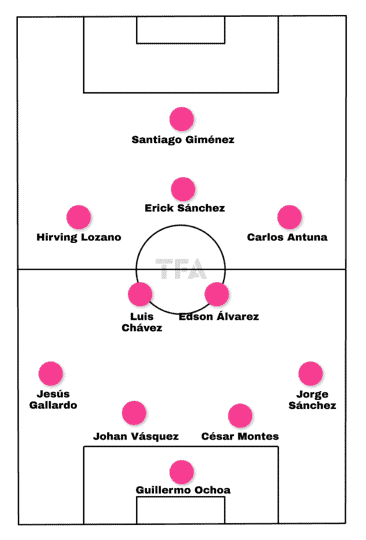
While 4-2-3-1 has been Mexico’s go-to shape in the past year, they are quite familiar with the 4-3-3 as well, so that could make an appearance this year.
The 4-2-3-1, however, lends itself more efficiently to a fully fit/available Mexico squad.
West Ham’s midfield anchor Edson Álvarez is set to play a vital role in this team, dictating the tempo of his side’s play in possession as well as providing the obvious defensive assistance that he is known for.
The presence of Luis Chávez next to him gives the Mexico midfield a great element of balance, which allows the front four more attacking freedom.
Attacking midfielder Erick Sánchez will provide a creative injection higher up the pitch while looking to bring attacking teammates into play in the final third.
Their attacking line is set to be led by Feyenoord forward Santiago Giménez.
The 23-year-old has had a storming season in Eredivisie, scoring 23 goals in 30 games and grabbing six assists.
There’s an elephant in the room to be addressed.
The image above represents what we initially thought Mexico’s lineup would look like, but boss Lozano has shocked many by leaving out some key names in his provisional 31-man squad.
Hirving Lozano, Raúl Jiménez, Jesús Gallardo, and national legend Guillermo Ochoa, who we were sure would be certain inclusions for Mexico in the year’s tournament, have not been included.
Jaime Lozano said that this decision was made after careful consideration as he looks to bleed through some of Mexico’s younger talent.
He did, however, say that those names left out this time still have a chance of playing in the 2026 World Cup.
In terms of Mexico’s number one keeper, that honour will fall to either Julio González, Luis Malagón, or Raúl Rangel.
Meanwhile, they have a couple of options when it comes to Hirving Lozano’s left wing position, which we will discuss later in this analysis.
Depth in other positions, particularly in terms of the players we expected to be involved but have since been left out, and who has taken their place, will also be addressed later on.
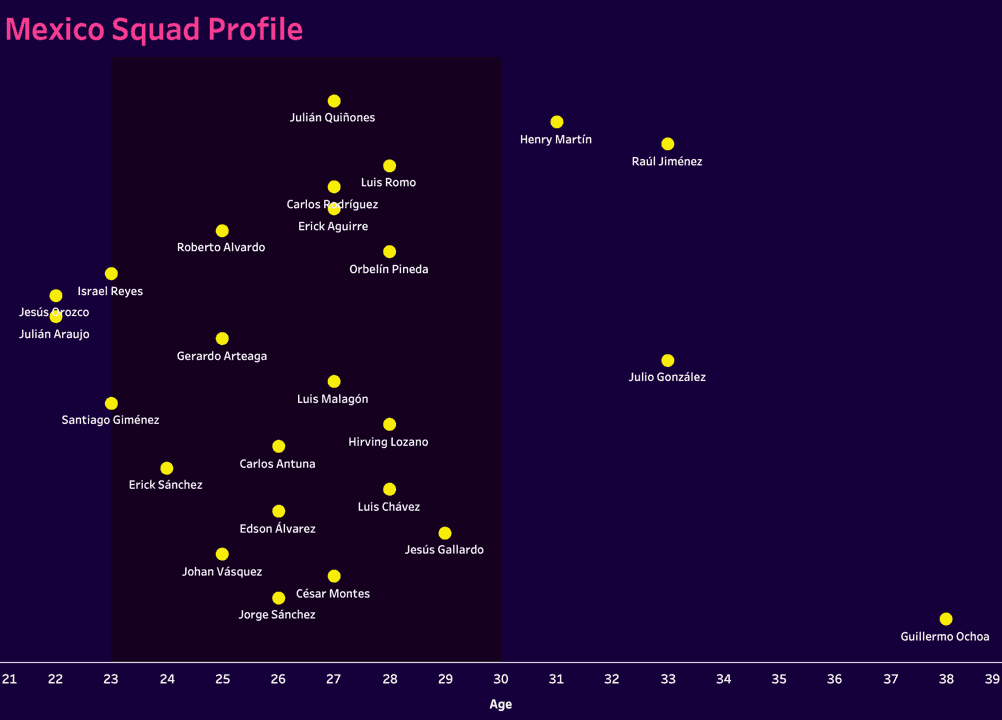
The aforementioned Ochoa is set to miss out on being Mexico’s oldest participant in the tournament, currently aged 38 – the squad in general is set to have a more youthful look that we expected – three of the four 30+ players in the graph above have been excluded from the provisional squad.
In general, we expect Mexico’s squad to be a mix of younger players and players in their prime years, especially after Jaime Lozano’s shock squad announcement – on the flip side, Expected starting forward Giménez is another of the younger players.
Seeing how he copes with the pressure of being on such an elite stage will be interesting.
Attacking phase
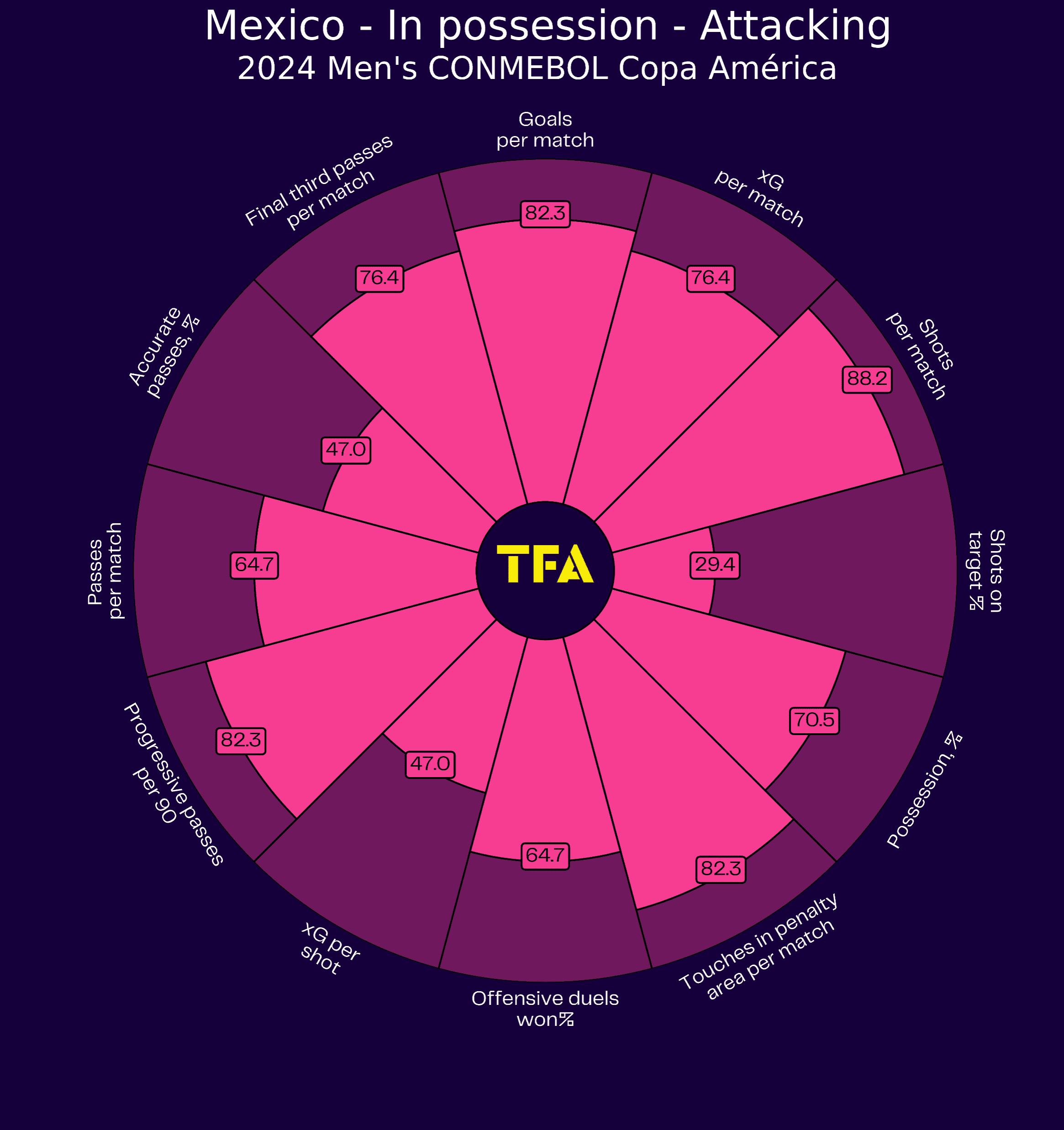
Some of the percentile rankings in the image above give us a sense of why Mexico are expected to at least get into the knockouts of this tournament – high ranks for goals, xG, shots, possession, and touches in the box all indicate a dangerous in-possession entity.
They also like to make quick progress up the pitch via progressive passes, which are chances to introduce the pace in wide areas and the attacking threat from central midfield.
In terms of their in-possession approach, Mexico have demonstrated the ability to be tactically versatile – they have experienced success in games where they dictate the tempo and control large portions of possession but also found triumph in more reserved attacking approaches when playing against teams who will dictate possession themselves.
However, as their percentile rank suggests, they are more accustomed to having more possession – that is their ideal approach, which is why this analysis will focus on that area of their play.
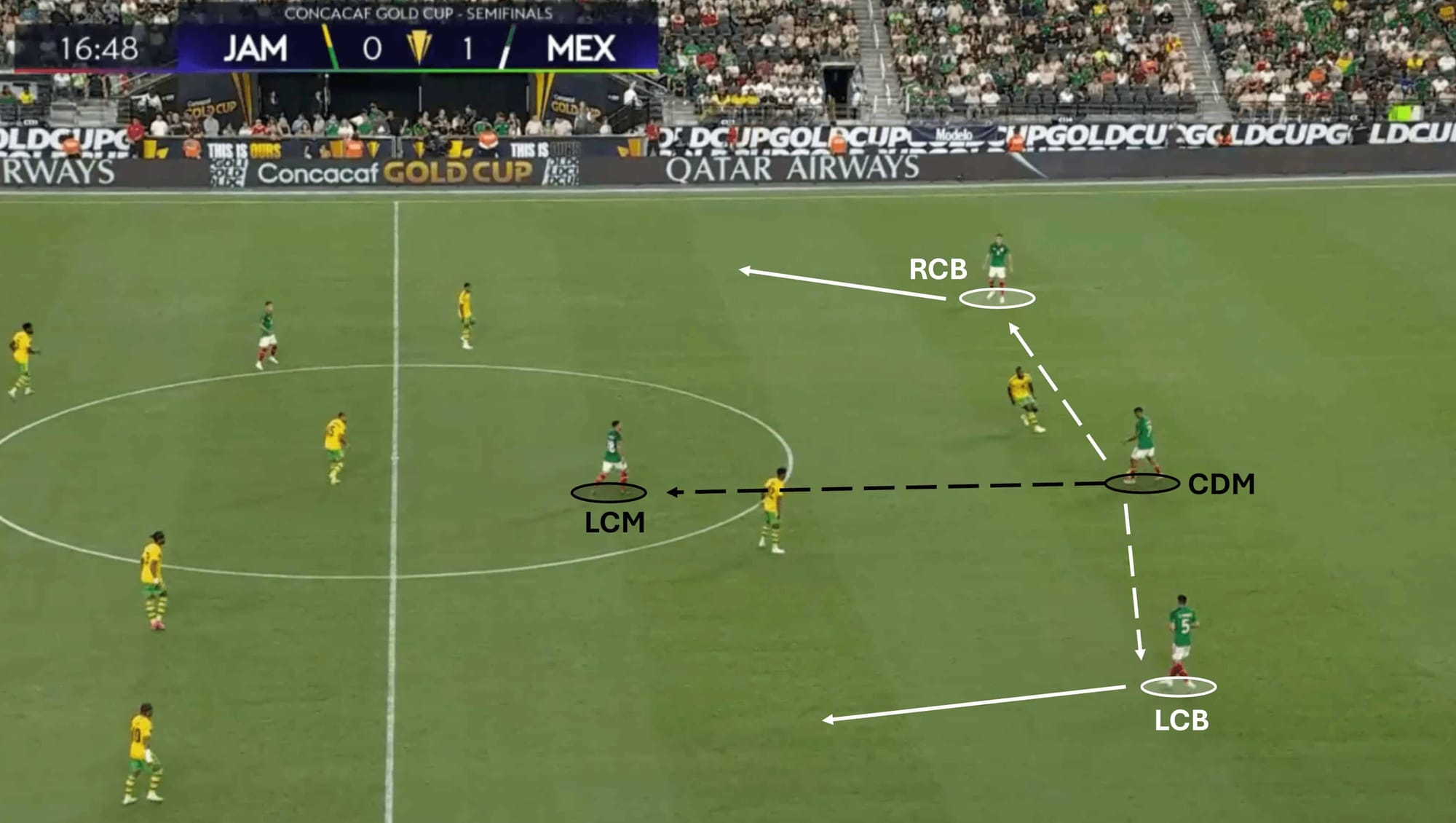
When Mexico have controlled, comfortable possession like the scenario above, they look to stretch the pitch as wide as possible with the aim of pushing the full-backs up the pitch.
In line with this movement, a deep midfielder will drop in to form a makeshift back three.
The example above is taken from a game where Mexico deployed a 4-1-4-1, so while some of the midfield positioning may change in a 4-3-3, the fundamental tactics will likely remain the same.
The aim of this makeshift back three is to try and play out from the back into higher areas.
Drawing the opposition to push higher up the pitch is an integral part of Mexico’s tactics – this opens up spaces further up the pitch for Mexico to exploit, which is where we often see the aforementioned progressive passes.
The central defenders on either side of the deep midfielder also have the freedom to drive the ball forward into midfield if it is safe to do so.
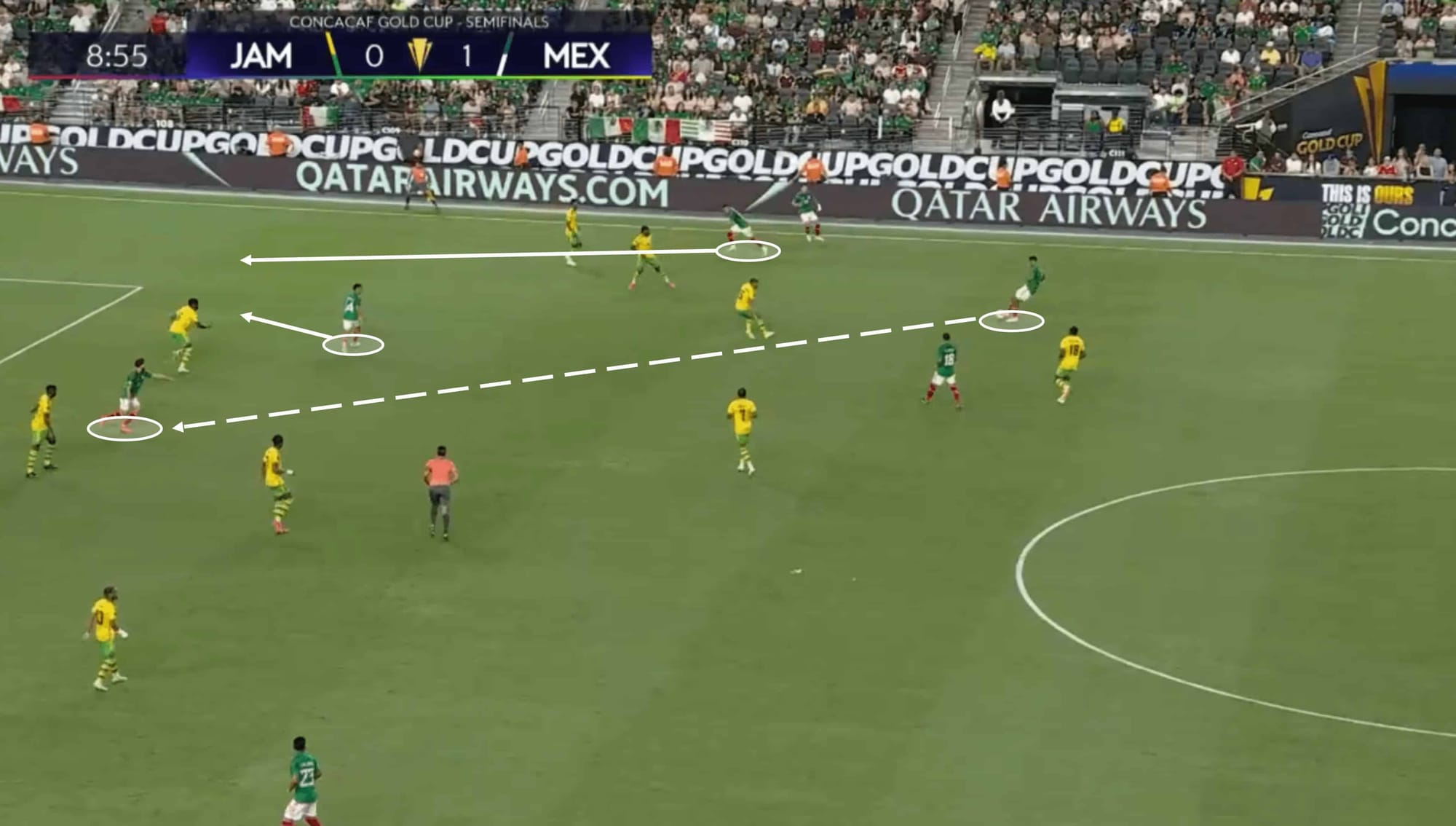
Once operating in high midfield/final third areas, pitch width remains equally important as it did earlier in the phase.
One thing that makes Mexico so dangerous in possession is their attacking versatility—they don’t live by one sole attacking method once they get into higher positions.
What does remain important, though, regardless of how they progress forward, is quick thinking and off-the-ball movements into space – risk-taking rather than playing the safe pass is also often highly encouraged.
The above example encompasses all of the elements mentioned just there as they look to penetrate Jamaica’s midfield and backline quickly with few passes.
Defensive Phase
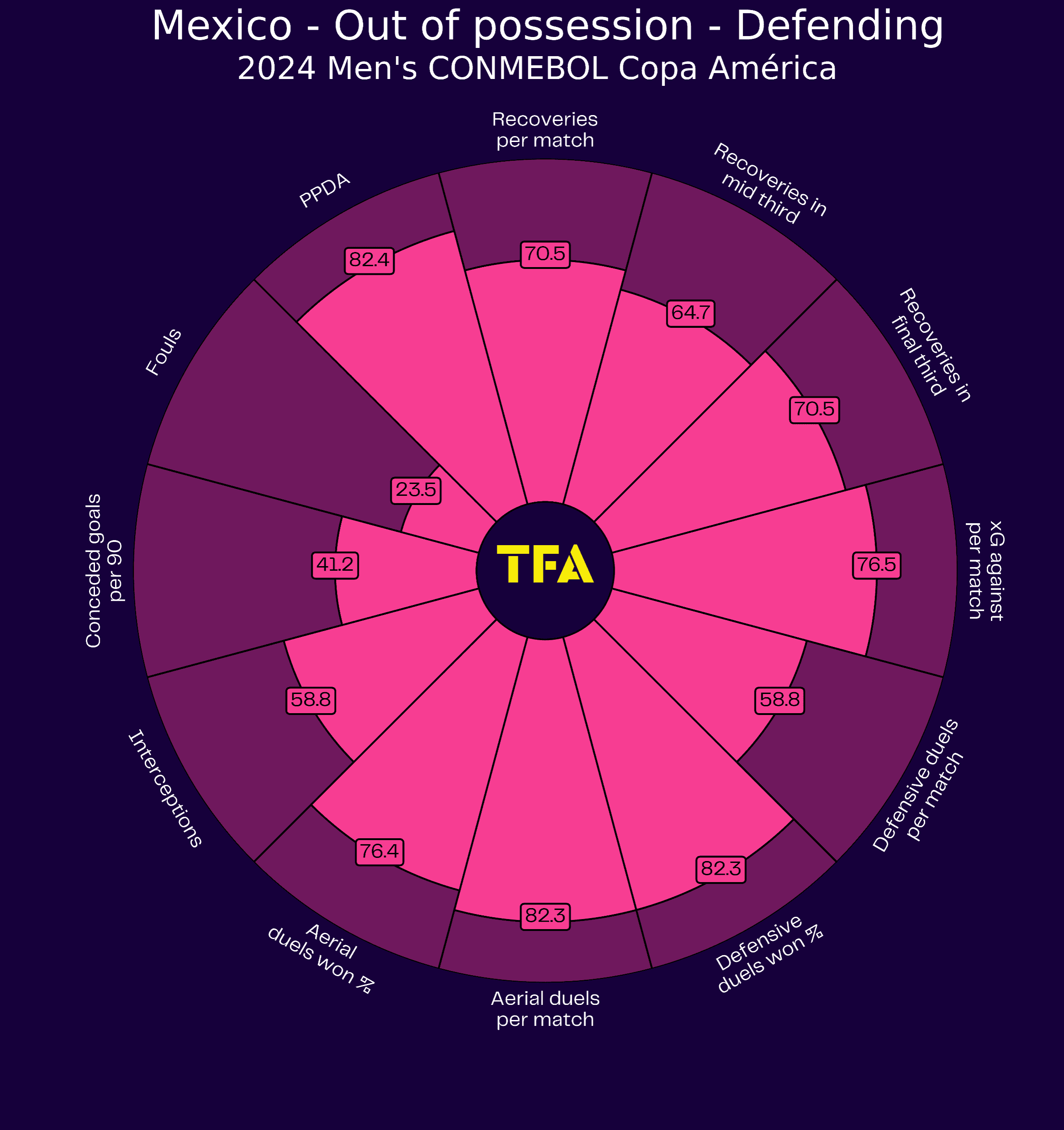
Mexico shows a similar balance of caution and aggression off the ball as well as on it.
The percentile chart above demonstrates that Mexico is a strong team defensively, but if you check their results over the past year, they are no strangers to conceding goals, something they will have to correct if they are to taste success this year.
Their areas of strength include consistently winning defensive and aerial duels and making a large number of recoveries, including in high areas.
As we will see below shortly, their high press is essential to their tactics, but they’re no stranger to regrouping and sitting slightly deeper either.
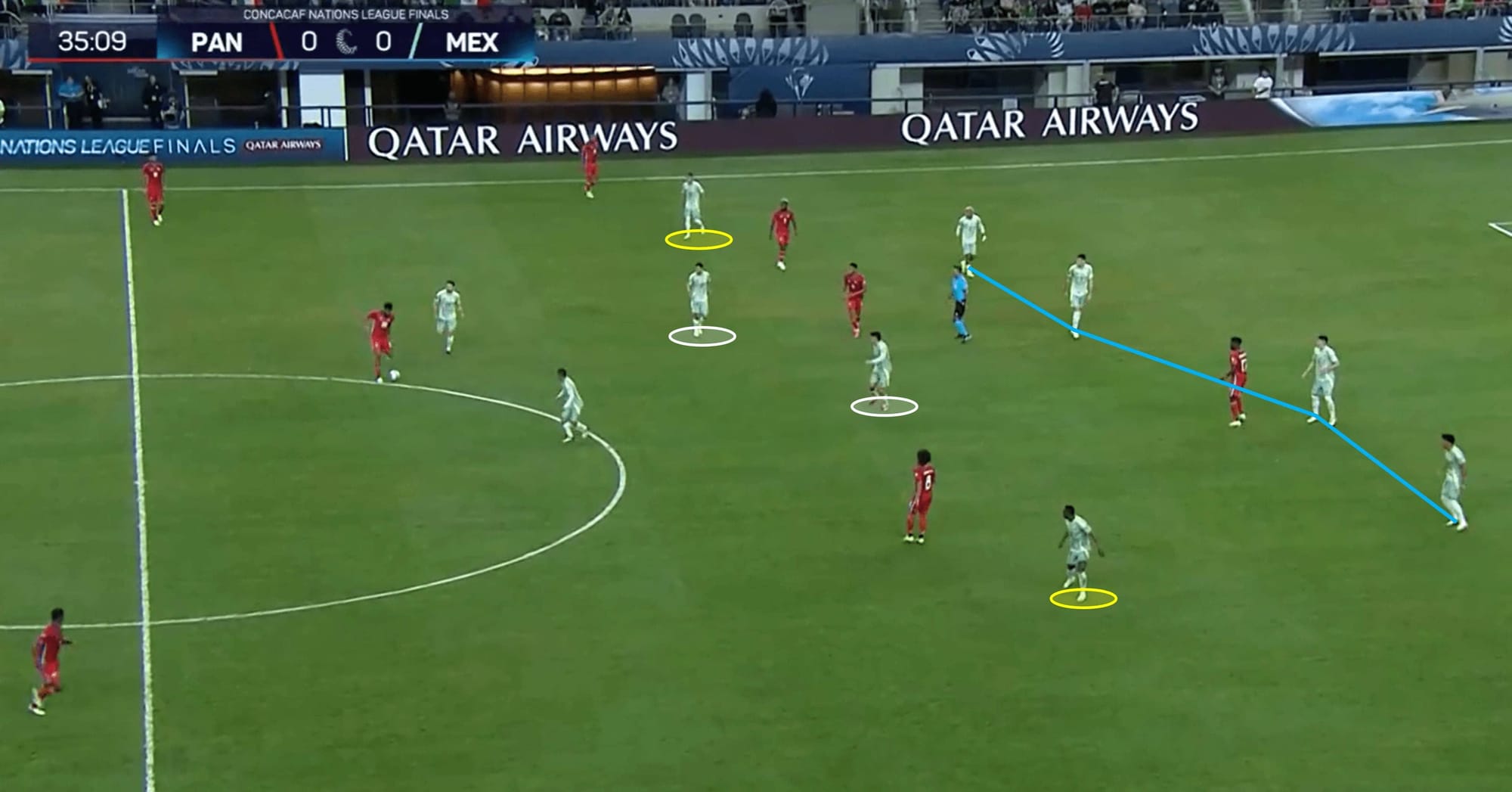
We mentioned earlier that Mexico go through games where their opponents enjoy the larger share of possession, so they have to be tactically equipped.
While defending from the front can work against possession-based teams, your higher-quality sides, like Brazil and Argentina, will just bypass that high press and carve the team open.
A compact shape from defence to attack is preferred when sitting deeper, minimising the chance of being penetrated in midfield areas.
The back four will often remain narrow, with the wide midfielders acting as wing-backs momentarily.
Elsewhere, the attacking midfielder and striker will look to harass the opposition but with caution in regards to leaving their position overexposed.
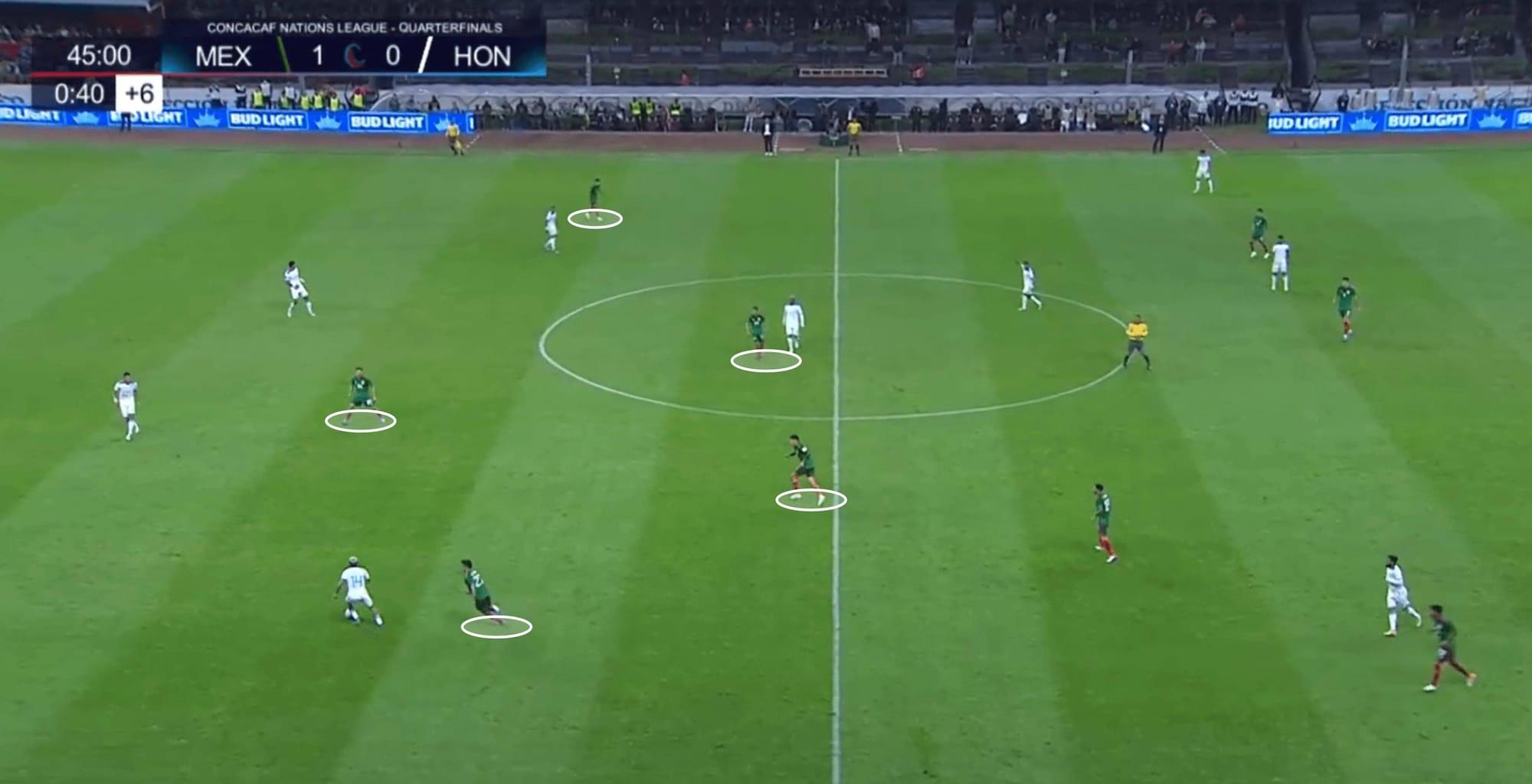
The image above mirrors what we are likely to see more of from Mexico in this tournament, particularly in the group stage—defending from the front.
Man-to-man marking and individual pressing are critical, while spare players in midfield will play an important role in transitions, as we see later on.
The main aim with this press is to force the opposition backwards if Mexico feel they are too deep for their liking or to force a mistake from the opponent, thus presenting possession back to Mexico.
Interestingly, the involvement of the full-backs in terms of a high press is mixed – there are times when they enter midfield zones to press the opposition wide players, but there are also times when they maintain their initial defensive positioning.
Transitions
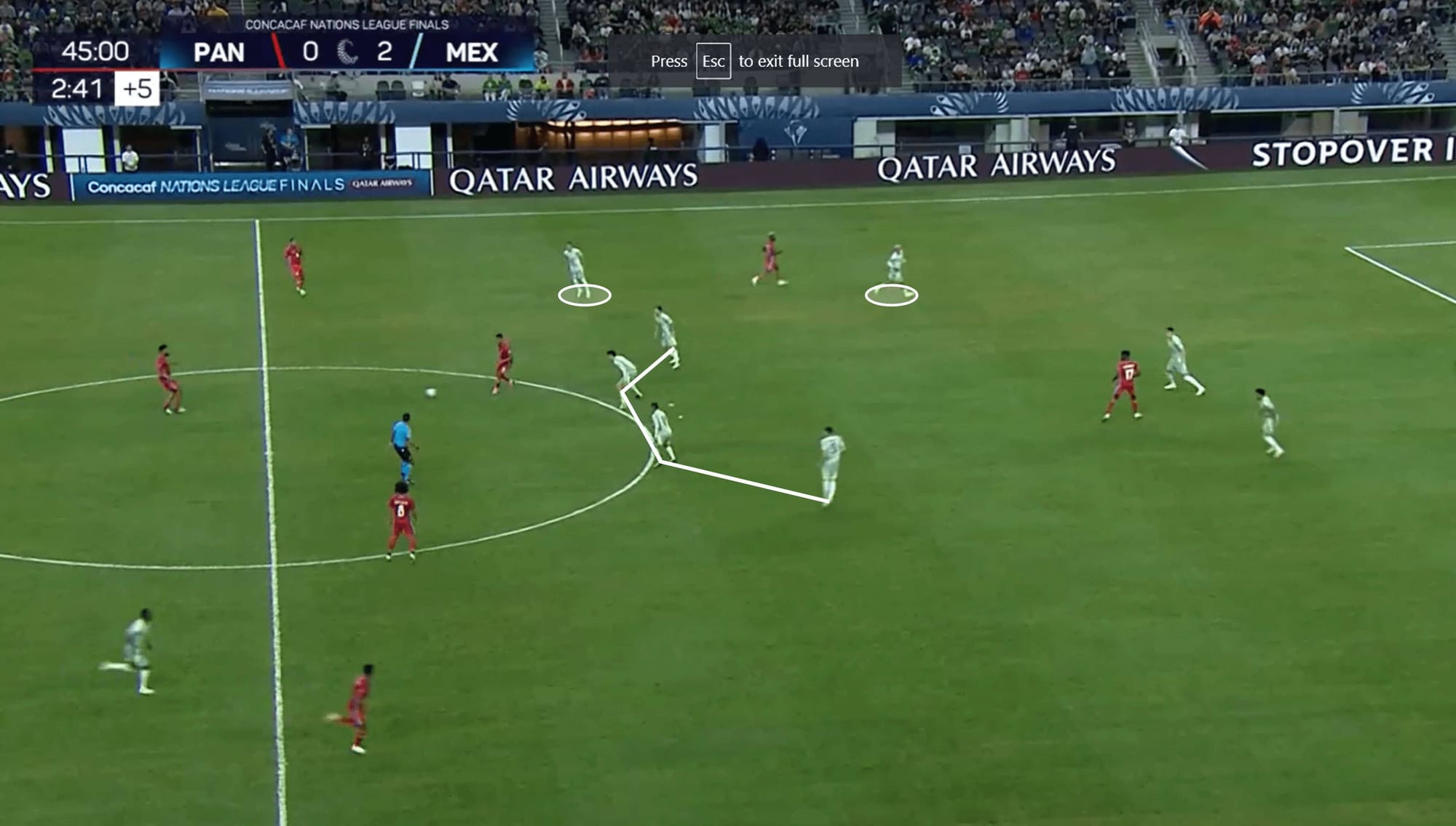
When defending a transitioning moment in play, Mexico must cover themselves in terms of their high attacking presence.
For this, they often focus on a couple of key areas, one of which is central midfield areas.
In the image above, that arched makeshift midfield four was not there when the transition started, but players regrouped into a position to form this defensive presence in central midfield.
Regarding wide protection, Mexico are aware of the danger of the switch pass during transitions and requires their wide midfielder on the opposite side of the transition to track back and provide defensive assistance to the full-back.
Of course, this individual role requires determination and work rate, among other traits.
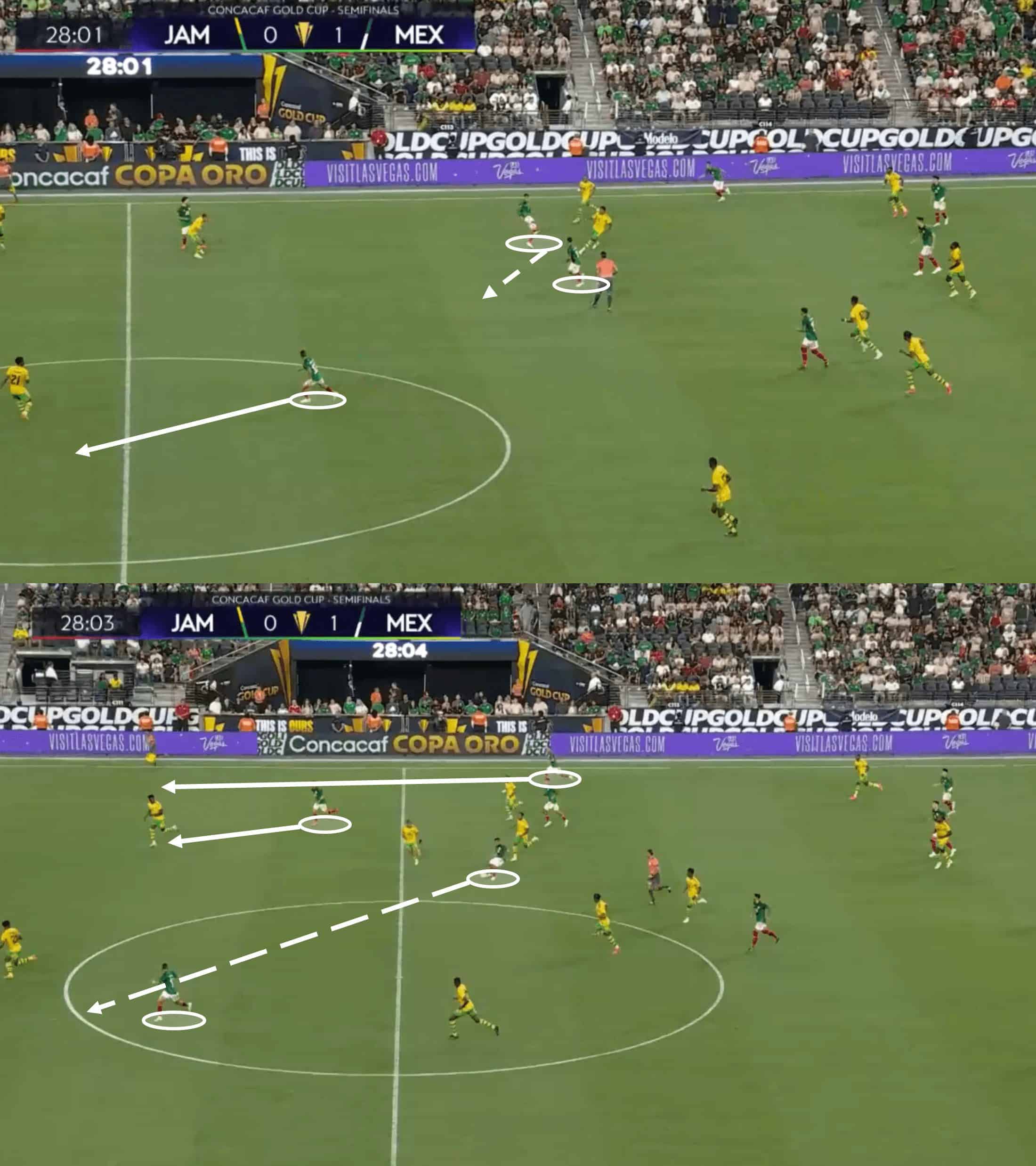
As you may have guessed, Mexico’s attacking transitions hold similar aggressive and direct traits to their general attacking tactics.
The example above demonstrates it well – the early runs from deep midfield, the pass into the space in midfield where no opposition player is present, and the quick progressive pass into a more attacking region, with yet again more dangerous forward runs to provide added support.
Forwards
As already explained, Feyenoord’s prolific Santiago Giménez is expected to lead his nation’s frontline in this tournament, but he has strong competition waiting in the wings.
Out wide, Julián Quiñones brings a strong element of versatility.
He can operate on either flank and play as a centre forward if required.
27-year-old Quiñones is an interesting one as he only recently received Mexican citizenship, making his debut in November 2023.
In recent club campaigns, he has brought a real energetic presence while also scoring.
He could well be a top contender to take Hirving Lozano’s spot on the left flank.
Along with those names, Mexico’s 31-man squad includes the likes of Marcelo Flores (who we have also highlighted as a potential breakthrough player, should he make the final 23-man squad), Cesar Huerta, Alexis Vegas, Diego Lainez, and Guillermo Martínez Ayala.
Henry Martin, however, misses out this time – as does Raúl Jiménez.
Midfielders
The central midfield trio in our predicted 11 will be hard to shake, but Mexico is set to have some interesting alternatives amongst the substitutes.
Orbelín Pineda is another player who brings the element of versatility.
He can operate as a deep midfielder, an eight, or a 10—he can also play on the left flank, so it is not hard to see why he is expected to feature for Mexico this upcoming tournament.
Roberto Alvardo is a more attacking option who can play on either flank (as a midfielder or winger), as a 10 or a CF.
At the same time, Carlos Rodríguez is both able to play a range of central midfield roles as well.
We expect all of those names to feature in Mexico’s squad, but as mentioned, the key three remain Edson Álvarez, Luis Chávez, and Erick Sánchez.
Additional midfield options in the provisional squad include Fernando Beltrán, Jordan Carrilo, and Andrés Montaño, while Erick Aguirre, and Luis Romo – all players we expected to be involved, have not been included in the 31-man squad.
Defenders
In recent fixtures, Mexico’s back four has been pretty consistent in terms of selection, and that is the four we listed in our predicted 11.
CB/RB Israel Reyes adds to that versatility notion – he can also play in central midfield and has played an important role at club level this season for América.
Young left-sided Jesús Orozco, able to play in the middle or as a full-back, has been involved in recent fixtures, making appearances from the bench as well as starting; his youth could be a welcome aspect.
As mentioned, he has full-back experience, but if he is to appear at this Copa America, expect it to be in the heart of the back four – Mexico’s first choice left-back looks to be Gerardo Arteaga of Monterrey, following the exclusion of Jesús Gallardo.
Other defenders in the provisional squad include Brian Garcia, Victor Guzman, and Bryan González.
Key Player
We’ve spoken about a few key names who are set to star for Mexico in this year’s competition.
For many, Edson Álvarez would be the pick of the bunch.
Now, we aren’t disputing the fact that the West Ham star will have a big say in how far his nation will go in the tournament, but we’d like to put the spotlight on another player who could steal the show.
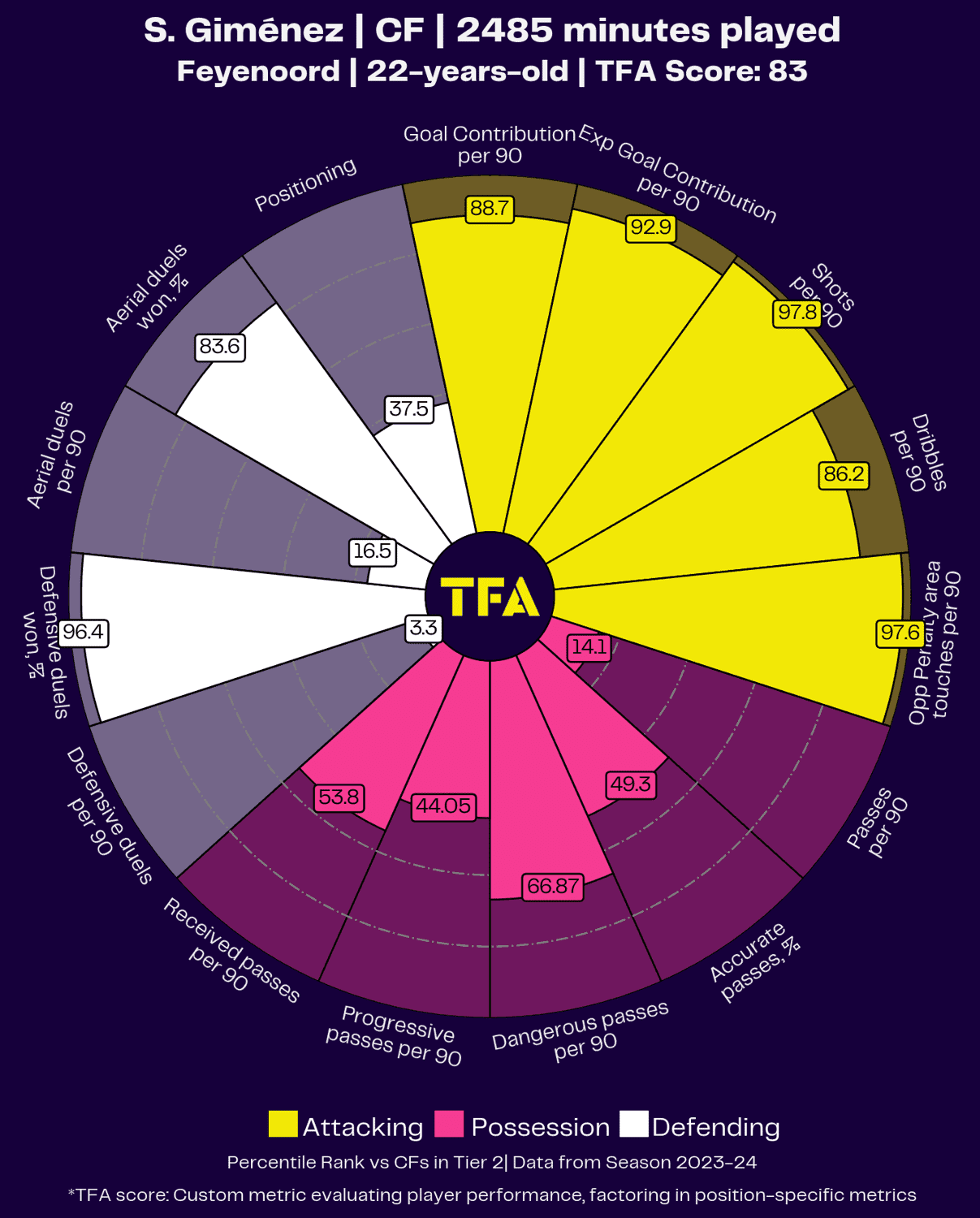
We’ve given him a brief mention already, but yes, Santiago Giménez could be Mexico’s shining star in the Copa America in 2024.
His goal record speaks for itself, and the rumours linking him to the Premier League, among other leagues, are no shock.
His varied physical skill set enables him to compete in several ways in the box and be dominant in duels – on the ground and in the air.
He doesn’t just put the ball in the back of the net, either – as you can see, he posts high percentiles for some creative metrics such as dribbles and dangerous passes, so Mexico will be hoping he can access his well-rounded set of attributes to fire them to the latter rounds of the competition.
Tournament Prediction
We touched on the fact that many oddsmakers have Mexico among the favourites to claim glory, behind some more obvious options.
The group stage is not going to be a walk in the park, though, especially with a seemingly new-look Mexico side who are looking to transition into the next generation of talent.
While we expect them to qualify for the knockout stages as champions of Group B, they’ll have to perform well to see off Ecuador, Venezuela, and Jamaica in what is set to be a highly competitive, closely contested group.
Should Mexico progress to the knockouts as Group B champions, they will likely face Argentina in the quarter/semi-finals, which will be a huge test if we see it come to fruition.
With that in mind, a journey to the final four is not unrealistic for Jaime Lozano’s side—they could even provide the shock factor for the tournament by going further!

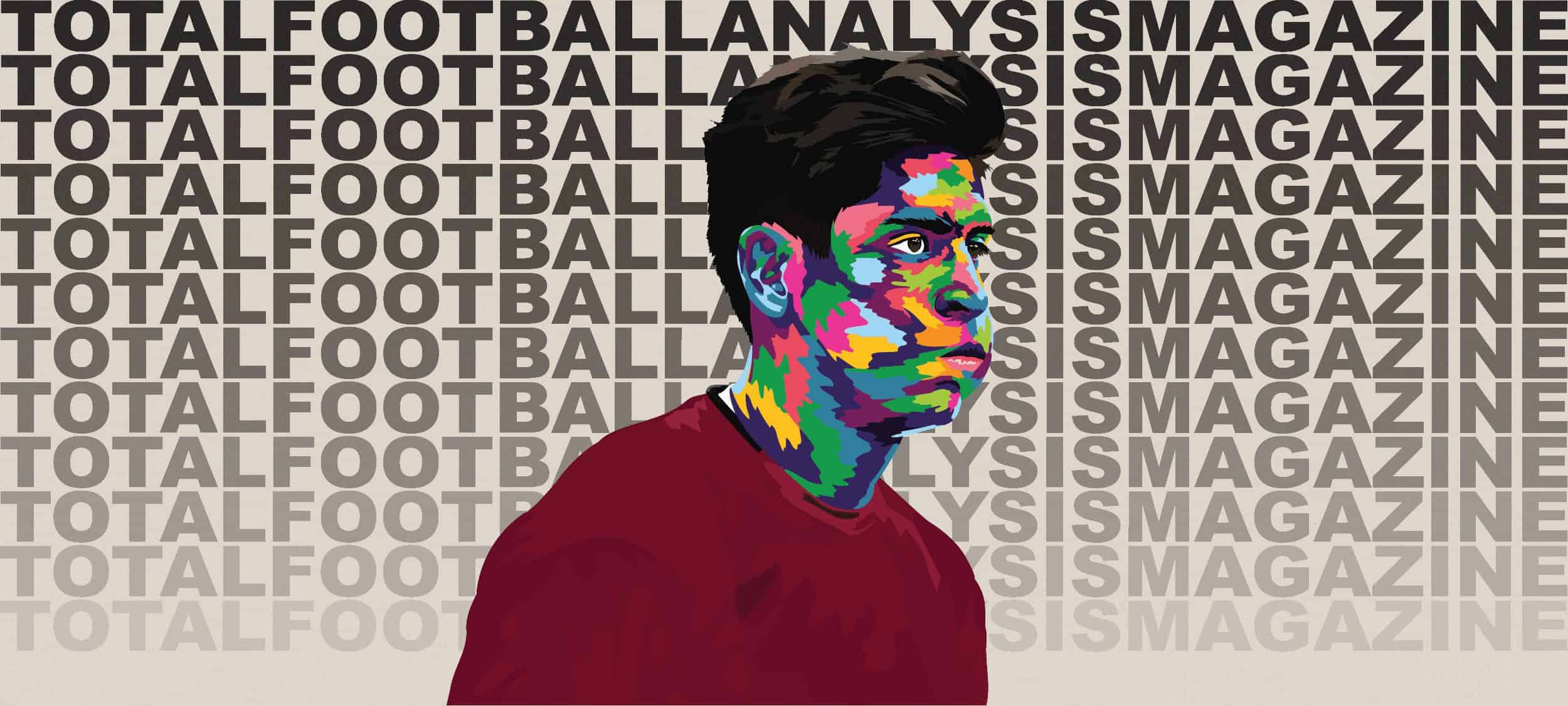




Comments